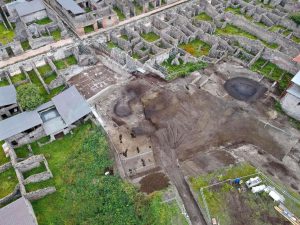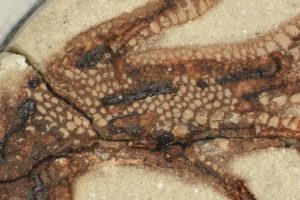Since it was rediscovered over 250 years ago, Pompeii has been an intriguing and popular destination for generations across the world. For its most recent resurgence, millennials have manifested their own captivation in site through the 2013 Bastille song about the city and a popular meme currently circulating around the internet. The meme, that began after CNN posted pictures from a dig site, shows an unnamed skeleton who appears to have initially escaped the volcanic ash, only to be then killed by a falling boulder. The irony of the situation inspired many to apply it to their own lives and it became a phenomenon on social media platforms.

A recent photo of an excavation site at Pompeii, Italy, most likely a similar setting to where the unnamed man was found. Photo provided by The Special Superintendency for the Archaeological Heritage of Naples and Pompeii, May 17, 2018.
However, in a Forbes article published in June, archaeologist Kristina Killgrove reports that through examining the skull of the skeleton, the archaeologists found that the man’s skull remained completely intact (Killgrove 2018). This helped them conclude that man had actually not been killed by the boulder, but instead, the upper part of the body had sunk during a previous excavation, causing it to appear that the boulder had been fatal. He most likely died due to asphyxiation. Although this essentially discredits the meme, the study of the man after he was buried led the team to further understand the context of Pompeii and the fate of one of its citizens. This type of inspection–the study of how an organism is buried and the processes that affect it after burial–is called taphonomy, and it remains widely important in the fields of archaeology and paleontology to explain why we find certain fossils and why we don’t, and how that affects the greater scheme of studying the past life (Renfrew 2010:41).

An artificially fossilized lizard foot, evidence of the some of the new technology being used by archaeologists to better understand taphonomy. Photo provided by Evan Sattia, Field Museum/University of Bristol and Tom Kaye, Foundation for Scientific Advancement
Through greater advances in technology, archaeologists are investigating how to replicate the fossilizing process, in order to better examine and understand decaying, and how one organism becomes a fossil. Evan Sattia of the Field Museum in Chicago explains in a July article for Popular Science that his team is essentially “baking” samples in clay tablets at 3500 psi, which is roughly the temperature of the level of the Earth’s crust where fossils are found. By replicating the process, scientists are able to probe into what temperature, gas, and other environmental effects lead to the fossilizing process and what materials are able to survive, a breakthrough in understanding how we find fossils and why we find them.
Although it is sometimes overlooked, taphonomy is a crucial part of the entire archaeological process within a site. The fossils that are left behind, allow archaeologists to peek further into the past living and provide a greater context of the past culture and environment of an area. And as evidenced through technological advances, taphonomy will continue, and should continue, to grow and improve along with further discoveries.
Further Readings:
Curren, Thomas.
2017 Archaeology as Blood Sport: How an Ancient Mastodon Ignited Debate over Humans’ Arrival in North America. Los Angeles Times, December 22, 2017. http://www.latimes.com/local/california/la-me-cerutti-mastodon-20171222-htmlstory.html#, accessed September 16, 2018.
Pickrell, John.
2018 Here’s How Humans Can Make It as a Fossil. Reader’s Digest, February 15, 2018. https://www.rd.com/culture/human-fossils/, accessed September 16, 2018.
Reference List:
Blakemore, Erin.
2018 To Understand Fossils, Scientists Are Baking Their Own. Popular Science, July 25, 2018. https://www.popsci.com/easy-bake-fossil, accessed September 16, 2018.
Killgrove, Kristina.
2018 That Meme-Worthy Pompeii Skeleton? Not Crushed By A Block, His Skull Shows. Forbes, June 28, 2018. https://www.forbes.com/sites/kristinakillgrove/2018/06/28/that-meme-worthy-pompeii-skeleton-not-crushed-by-a-block-his-skull-shows/#7a375b9a1c61, accessed September 16, 2018.
Renfrew, Colin and Paul Bahn.
2010 Archaeology Essentials. 2nd edition. Thames & Hudson, New York.
Images:
Blakemore, Erin.
2018 To Understand Fossils, Scientists Are Baking Their Own. Popular Science, July 25, 2018. https://www.popsci.com/easy-bake-fossil, accessed September 16, 2018.
McGrath, Maryellen.
2018 Extraordinary discovery of the archaeological site of Pompeii. ABC News, May 19, 2018. https://abcnews.go.com/International/extraordinary-discovery-archaeological-site-pompeii/story?id=55237858, accessed September 16, 2018.
